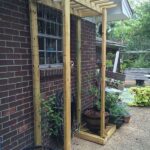Are you looking to add a unique and visually appealing element to your garden or yard? Look no further than simple rock landscaping ideas. Rocks can add a natural and rustic charm to any outdoor space, while also offering numerous practical benefits. From creating pathways and borders to reducing the need for maintenance, rock landscaping can elevate the aesthetic and functionality of your outdoor area.
When it comes to incorporating rocks into your landscape design, there are various types to consider. River rocks, gravel, boulders, and flagstone are just a few options that can be used creatively to enhance the overall look of your garden or yard. Each type of rock offers its unique characteristics and can be utilized in different ways to achieve the desired aesthetic.
In this article, we will explore the beauty and benefits of simple rock landscaping while delving into types of rocks, planning and design tips, plant pairings, low-maintenance garden ideas, rock pathways, wall features, and maintenance. Whether you are aiming for a serene rock garden oasis or hoping to reduce the time spent on upkeep, there are plenty of creative ways to incorporate rocks into your outdoor space.
Types of Rocks
When it comes to simple rock landscaping ideas, the type of rocks used can really make a difference in the overall look and feel of a garden or yard. There are various options to choose from, each with its own unique characteristics and benefits.
River rocks, for example, are smooth and come in an assortment of colors, making them a versatile choice for adding texture to the landscape. On the other hand, gravel is a popular option for pathways and ground cover due to its low maintenance and cost-effective nature.
Boulders
Boulders are large rocks that can be used as focal points or as a way to create natural barriers or boundaries within a garden. They add visual interest and a sense of depth to the landscape design, especially when placed strategically throughout the space.
Flagstone
Flagstone is a type of flat sedimentary rock that is often used for creating walkways, patios, and stepping stones. Its irregular shapes and earthy colors make it an attractive choice for adding a rustic touch to any outdoor area.
Whether you’re looking to add decorative accents, create functional pathways, or build structural features in your landscape design, choosing the right type of rocks will play a significant role in achieving your desired aesthetic. By considering factors such as color, shape, size, and texture, you can select rocks that complement your overall vision for your outdoor space.
Planning and Design
When planning and designing a rock garden, it’s essential to consider the placement of different colors, shapes, and sizes of rocks to create an aesthetically pleasing outdoor space. Here are some tips and tricks to help you achieve the perfect simple rock landscaping for your garden or yard:
- Create Depth: Use a variety of rock sizes to create depth in your rock garden. Place larger rocks towards the back or center of the garden, gradually using smaller rocks towards the front or edges. This layering effect will add visual interest and dimension to your landscape.
- Consider Color Contrast: Incorporating rocks with different colors can add drama and contrast to your rock garden. Pair warm-toned rocks like sandstone with cool-toned rocks like slate for a striking effect. You can also mix in different shades of the same color for a more subtle look.
- Mix Textures: Combining rocks with different textures can add visual appeal to your landscaping design. Pair rough-textured rocks with smooth ones to create an interesting tactile experience in your garden.
By incorporating these planning and design tips into your rock landscaping project, you can create a visually appealing outdoor space that enhances the natural beauty of your yard while reducing maintenance requirements at the same time. Whether you’re using river rocks, boulders, gravel, or flagstone, thoughtful design and placement can elevate the overall look and feel of your simple rock landscaping ideas.
Remember to visualize how everything will look when finished before starting – put it on paper. When every detail is thought out through this simple exercise everything seems simpler along with less backtracking once real work starts.
Plant Pairings
When it comes to simple rock landscaping ideas, finding the perfect plants and flowers to pair with your rock garden is crucial to creating a balanced and beautiful outdoor space. The right plant pairings can enhance the natural beauty of the rocks while adding color, texture, and dimension to your garden. Here are some tips for choosing the best plants and flowers to complement your simple rock landscaping.
Choosing Drought-Tolerant Plants
One of the great benefits of pairing plants with rocks in landscaping is that it allows you to create a low-maintenance garden. Look for drought-tolerant plants that require minimal water, such as succulents, lavender, ornamental grasses, and yarrow. These plants not only thrive in rocky environments but also add an interesting contrast to the texture of the rocks.
Creating Contrast With Colorful Flowers
Incorporating colorful flowers into your rock garden can add a pop of brightness and vibrancy. Choose flowering plants like petunias, dianthus, or portulaca to bring life and energy to your landscape design. Consider planting them in between rocks or along pathways for a whimsical effect.
Utilizing Groundcovers
Groundcover plants are an excellent choice for filling in gaps between rocks and creating a lush, carpet-like appearance. Creeping thyme, sedum, and ice plant are all fantastic options for spreading over bare soil while adding visual interest to your simple rock landscaping. Plus, these groundcovers help suppress weed growth and prevent erosion in your garden.
By carefully selecting the right plants and flowers to complement your simple rock landscaping, you can elevate the overall look of your outdoor space while minimizing maintenance requirements. Whether you opt for drought-tolerant plants, colorful flowers or groundcovers, incorporating greenery into your rock garden will undoubtedly create a harmonious balance between natural elements.
Rock Pathways
- Natural Stone Stepping Stones: Using natural stone stepping stones as a pathway creates a rustic and charming look in your garden. These can be placed directly on the ground or nestled into gravel for a more defined pathway.
- Gravel Paths: One of the most simple rock landscaping ideas is to create a gravel path with decorative rocks of varying sizes and colors. This low-maintenance option is perfect for creating meandering pathways and borders in any outdoor space.
- Border Edging with River Rocks: Use river rocks to edge your garden paths for a clean and polished look. You can place them directly alongside your pathway or create a wider border with decorative pebbles for added visual appeal.
Incorporating rock pathways into your garden not only adds beauty and character but also provides practical benefits such as reducing erosion, preventing soil compaction, and minimizing maintenance needs. By implementing these simple rock landscaping ideas, you can transform your outdoor space into a beautiful and functional oasis.
Low-Maintenance Garden Ideas
Creating a low-maintenance garden using simple rock landscaping ideas is an excellent way to reduce the need for regular watering, weeding, and overall maintenance in a garden or yard. By strategically placing rocks and incorporating low-maintenance plants, you can achieve a beautiful outdoor space that requires minimal upkeep.
One of the key benefits of utilizing rocks in landscaping is their ability to retain moisture and reduce evaporation, ultimately reducing the need for frequent watering. In addition, rocks can help suppress weed growth by blocking sunlight and preventing weed seeds from germinating.
When implementing simple rock landscaping ideas for low-maintenance gardens, consider using river rocks or gravel as ground cover instead of traditional mulch. These materials not only provide a clean and polished look but also help inhibit weed growth while requiring very little maintenance.
Incorporating drought-tolerant plants that thrive in rocky environments is another effective strategy to minimize watering and upkeep. Succulents, ornamental grasses, and wildflowers are great options to pair with rock landscaping, as they can withstand dry conditions and do not require frequent watering.
Incorporating rock pathways into your garden design is another way to minimize maintenance while adding visual interest to the landscape. By creating pathways using various sizes and colors of rocks, you can reduce the need for mowing or trimming around walkways.
Additionally, rock pathways allow for better drainage in the garden and prevent soil compaction in high-traffic areas. To further enhance the low-maintenance aspect of your garden, consider using large boulders as focal points or natural barriers to define different zones within the landscape.
| Benefits | Materials |
|---|---|
| Reduced need for watering | River rocks |
| Suppressed weed growth | Gravel |
| Low maintenance plants | Succulents |
| Better drainage | Boulders |
Rock Wall Features
Using rocks to create retaining walls, borders, and other structural features in a landscape design can add both functionality and aesthetic appeal to any outdoor space. Retaining walls made of rocks can help prevent erosion on slopes and create a visually appealing tiered effect in a yard or garden.
Borders made of rocks can define different areas of the landscape and provide a natural-looking transition between various elements. Additionally, incorporating rocks into the overall design can bring texture, depth, and character to the outdoor environment.
When considering rock wall features for a landscape design, it’s essential to select the right type of rocks that will complement the existing elements while also serving their intended purpose. For retaining walls, larger boulders and stones may be more suitable for added stability, while smaller river rocks or gravel may work well for decorative borders. The placement of these rocks is also crucial; they should be strategically positioned to ensure proper drainage, support, and visual appeal.
For DIY enthusiasts looking to incorporate rock wall features into their landscape design plans, there are various online resources available with simple rock landscaping ideas for creating retaining walls, borders, and other structural elements. These resources often provide step-by-step guides on how to plan, prepare the area, select materials, and construct these features effectively. With proper planning and execution, any homeowner or landscaper can add value and beauty to their outdoor space with carefully designed rock wall features.
| Rock Wall Feature | Recommended Rock Type |
|---|---|
| Retaining Walls | Larger boulders or stones |
| Borders | River rocks or gravel |
Rock Garden Maintenance
In conclusion, simple rock landscaping ideas can truly transform a garden or yard, adding texture, color, and natural beauty to outdoor spaces. Whether it’s using river rocks, gravel, boulders, or flagstone, the variety of rocks available offers endless possibilities for creating a stunning landscape. When planning and designing a rock garden, it’s important to consider the different colors, shapes, and sizes of rocks to achieve a balanced and visually appealing result.
Pairing plants and flowers with simple rock landscaping can further enhance the overall look of the outdoor space. Choosing the right plant pairings can create a harmonious and inviting atmosphere that complements the rugged beauty of the rocks. Additionally, incorporating rock pathways not only adds aesthetic value but also serves a functional purpose by defining walkways and creating borders within the garden or yard.
One of the greatest benefits of simple rock landscaping is its low maintenance requirements. With minimal watering and weeding needed, this type of landscaping is an ideal choice for those looking to reduce their outdoor maintenance workload.
Finally, maintaining a rock garden involves regular weed control, erosion prevention measures, and seasonal upkeep to keep the landscape looking its best year-round. By following these tips and advice on maintenance, homeowners can continue to enjoy their beautiful rock garden for years to come.
Frequently Asked Questions
What Is the Least Expensive Way to Landscape?
The least expensive way to landscape is to focus on low-maintenance plants and simple design elements. Choosing native plants that thrive in your area, using mulch instead of expensive landscaping materials, and DIY projects can help keep costs down. Regular maintenance and upkeep can also prevent the need for costly repairs or replacements.
What Do You Put Down Before Rocks for Landscaping?
Before laying rocks for landscaping, it’s important to put down a layer of landscaping fabric or weed barrier. This helps prevent the growth of weeds and keeps the rocks in place, reducing maintenance over time. Additionally, edging made of plastic or metal can help contain the rocks and give a clean, finished look to the landscaping.
How Do You Make Rock Landscaping Look Good?
To make rock landscaping look good, consider incorporating a variety of rock sizes and colors for visual interest. Mixing different types of rocks like river rocks, gravel, or boulders can add texture and depth to the landscape.
Creating focal points with rock features like a small rock garden or dry creek bed can also enhance the overall aesthetic appeal of the space. Lastly, consider incorporating low-maintenance plants and ground cover around the rocks to soften their appearance and add color to the landscape.

Welcome to my gardening blog! I am passionate about plants and enjoy sharing my knowledge and experiences with others. In this blog, I will write about everything related to gardening, from tips on how to get started to updates on my own garden projects.





